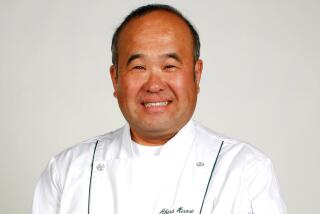The House of Kanze by Nobuko Albery (Simon & Schuster: $17.95; 320 pp.)
- Share via
Noh actors don’t plant rice, don’t trade, don’t run amok with swords, says the comic Orgame, explaining his craft. By singing and dancing, they remind their audience of the way of Buddha--beyond this Terminal World is the Heaven of Blissful Peace.
“The House of Kanze” by Nobuko Albery is an English-language historical novel that traces three generations of Noh actors during the 14th-Century Ashikago shogunate in Japan. It is a time of feuds, clan rivalries and intrigue that includes in its sweep as well the more personal tragedies of illness and death in the family. More than anything, the novel means to make the reader aware of the fragility of human life, the longevity of art.
Against this backdrop of a military Japan, the actors make their way to the center of civilization, Kyoto, and put together a troupe that wins over local audiences and finally the shogun Yoshimitsu himself, whose patronage ensures their success.
The central character, the actor Zeami, shines with the same sort of radiance as Genji, the prince in Shikubu Murasaki’s 11th-Century Japanese classic. Moreover, he possesses a sensibility (and therefore ability on stage) born of humiliation (the actors are untouchables), discipline, selflessness. An actor’s duty is to please, his father says.
As a young boy, Zeami is raped by a Jozen monk, taken as his male favorite by the shogun, harshly disciplined by his father in the ways of Noh. Since the author has no access to the details of such training, it is alluded to: The father passes his intuitive feeling of the roles and movement on stage to his son by “secret transmission.”
After a retreat from the theater into madness and a monastery, Zeami emerges not only as a great actor but also as a playwright whose plays he hopes will survive “my perishable flesh.” Through it all, the characters repeat, there is just Noh: “The integrity of our Way is our lifeline. . . . Never forget the beginner’s awe.”
Zeami’s adopted son receives the transmission, not because of inherent talent but because he remains loyal to Noh, his brothers having deserted for love or Zen. Thus the novel ends with Zeami, soon to be exiled for complicated political reasons, training his son in the roles not only of warrior and demon but also in the more taxing ones of the female, the possessed, the aged. At whatever cost, the family knowledge must be passed down: “At times, Zeami’s method of coaching appeared indistinguishable from torture.”
The final vision of the frail, 70-year-old Zeami is in a performance of the heron dance, having lost himself so thoroughly in the bird that he seems to fly off stage. Occasionally, though not frequently enough for me, the author tells of a particular theatrical moment, as here or as in the story of a warrior’s ghost singing to his inconsolable wife. Yet, it seems rather that the novel, with its similar concerns of transience and the elegiac, substitutes itself for the plays.
I was moved by the image of art against time, but the novel doesn’t quite match its ambitions as do the novels by the Japanese author Yasunari Kawabata, Nobel laureate in 1968. “The House of Kanze” provides valuable background information and invents interesting characters for masters about whom as little is known, the author acknowledges, as about Shakespeare. I enjoyed the construct, yet found the book too frequently rhapsodic, as if the ideals of Noh could be transmitted directly to a novel about them.
More to Read
The biggest entertainment stories
Get our big stories about Hollywood, film, television, music, arts, culture and more right in your inbox as soon as they publish.
You may occasionally receive promotional content from the Los Angeles Times.










